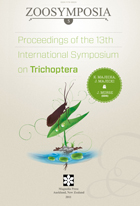Abstract
Lake Balaton is the largest shallow lake in Central Europe. A large part of its catchment area is a reputable and popular tourism area, where the quality of surface waters is in the center of public and scientific interest. The inflows of Lake Balaton are vulnerable, due to the strong human activity upstream. Despite their significance, the aquatic macroinvertebrate communities of these inflow streams are poorly known. In the summer of 2008, we investigated the distributional pattern of EPT (Ephemeroptera, Plecoptera, Trichoptera) assemblages, and their relationships with selected physico-chemical factors and landscape characteristics at different spatial scales. Samples were taken according to the AQEM sampling protocol at 20 stream sections with different environmental conditions. Multivariate analyses were used for evaluation. Altogether 8131 specimens (6225 Ephemeroptera, 133 Plecoptera, 1773 Trichoptera) belonging to 55 species (25 Ephemeroptera, 2 Plecoptera, 28 Trichoptera) were identified. Cloeon dipterum (L.) and Baetis spp. were the most common mayfly taxa, while caddisfly communities were dominated by limnephilids [Anabolia furcata Brauer, Potamophylax rotundipennis (Brauer)] and hydropsychids [Hydropsyche saxonica McLachlan, H. angustipennis (Curtis)]. The distribution of EPT assemblages was highly affected by pH, conductivity, dissolved oxygen, temperature and total dissolved solids. At reach scale, relationships were detected between spatial patterns of EPT assemblages and structure of riparian vegetation, type of sediment, and some hydromorphological characteristics (e.g., depth and width of stream bed, cover of aquatic vegetation, etc.). At medium and large scale, the ratio of natural and human-impacted areas proved to be the most influential factor.

